Potřebujeme váš souhlas k využití jednotlivých dat, aby se vám mimo jiné mohly ukazovat informace týkající se vašich zájmů. Souhlas udělíte kliknutím na tlačítko „OK“.
ASTM D6758-08
Standard Test Method for Measuring Stiffness and Apparent Modulus of Soil and Soil-Aggregate In-Place by Electro-Mechanical Method (Withdrawn 2017)
Automaticky přeložený název:
Standardní zkušební metoda pro měření tuhosti a zdánlivý modul půdy a její kameniva v místě by Elektro-mechanický způsob
NORMA vydána dne 1.1.2008
Informace o normě:
Označení normy: ASTM D6758-08
Poznámka: NEPLATNÁ
Datum vydání normy: 1.1.2008
Kód zboží: NS-36425
Počet stran: 5
Přibližná hmotnost: 15 g (0.03 liber)
Země: Americká technická norma
Kategorie: Technické normy ASTM
Kategorie - podobné normy:
Zemní práce. Hloubicí práce. Budování základů. Podzemní práce
Anotace textu normy ASTM D6758-08 :
Keywords:
compaction control, in-place modulus, in-place stiffness, in-situ test, non-destructive, production testing, shear modulus, soil stiffness test, stiffness gauge, Young´s modulus, Compaction control, Electromechanical processing/devices, In-place stiffness, Modulus--soil/rock applications, Nondestructive evaluation (NDE)--soil/rock/related materials, Shear modulus, Soil-aggregate, Soil stiffness, Young&apos,s modulus
Doplňující informace
| Significance and Use | ||||||||||||||||||
|
The apparatus and procedure described provides a means for measurement of the stiffness of a layer of soil or soil-aggregate mixture from which a Young's modulus may be determined for an assumed Poisson's ratio. Low strain cyclic loading is applied by the apparatus about a static load that is consistent with highway applications (1). This method is useful as a non-destructive method for monitoring or controlling compaction so as to avoid under-compaction, over-compaction or wasted effort. Through an understanding of how stiffness relates to density for a particular material, moisture content and compaction procedure, the stiffness achieved can be related to % compaction in connection with density based compaction control or specifications, for example, to meet the requirements of Method D 698 using standard effort or Method D 1557 using modified effort. This method applies to silty and clayey materials containing greater than 20 % fines. In such cases, the relationship between stiffness and dry density or dry unit weight is sensitive to the water content. Water contents should be determined by use of: Test Method D 2216, D 4643, or D 4959. If the determination cannot be made immediately at the time of the stiffness measurements, then soil samples shall be preserved and transported in accordance with Practice D 4220, Section 8, Groups B, C, or D soils. This method is useful in the construction of road bases or earthworks, including the installation of buried pipe (2). The rapid, non-penetrating nature of this method is suited to production testing, for example, it provides a means of testing that does not necessarily interfere with or delay construction. This method is suitable for mitigating the risk of pavement failure. By assuring the relative uniformity of highway subbase, subgrade and base stiffnesses, stresses on the pavement is more uniformly distributed. In this way the life of a pavement is extended and repairs minimized. This method is suitable for determining when the surface of a soil or soil-aggregate structure is capable of supporting design loads. This is useful for stabilized fills where the material hardens (stiffens) over time without measurable changes in density or moisture content. This test method is suitable for the in-place determination of a Young's and a shear modulus of soil and soil-aggregate mixtures (3, 4). Stiffness, as measured by this method, is related to modulus (5) from an assumption of Poisson's ratio and from the radius of the foot of the apparatus as follows:
The stiffness and modulus of silty and clayey materials will change with moisture content and can possibly result in hydro-compaction collapse, loss of bearing capacity or loss of effective shear strength. In addition, for silty and clayey materials with significant fines content, higher stiffness does not necessarily assure adequate compaction (6). |
||||||||||||||||||
| 1. Scope | ||||||||||||||||||
|
1.1 This test method covers the measurement by electro-mechanical means of the in-place stiffness of soil or soil-aggregate mixtures so as to determine a Young's modulus based on certain assumptions. The apparatus and procedure provide a fairly rapid means of testing so as to minimize interference and delay of construction. The test procedure is intended for evaluating the stiffness or modulus of materials used in earthworks and roadworks. Rapid in-place stiffness testing supports U.S. federal and state efforts to specify the in-place performance of construction materials based on modulus. Results obtained from this method are applicable to the evaluation of granular cohesionless materials. They are also applicable to the evaluation of silty and clayey materials with more than 20 % fines that are not subject to a change in moisture content. If the silty and clayey material experiences a change in moisture content, then moisture content shall be taken into account if the results of this method are to be applicable. The stiffness measured with this method is influenced by boundary conditions, specifically the support offered by underlying layers as well as the thickness and modulus of the layer being tested. Since this method approximates the layer(s) being evaluated as a half-space, then the modulus measured is also approximate. 1.2 The stiffness, in force per unit displacement, is determined by imparting a small measured force to the surface of the ground, measuring the resulting surface velocity and calculating the stiffness. This is done over a frequency range and the results are averaged. 1.3 The values stated in SI units are to be regarded as the standard. The inch-pound units equivalents may be approximate. 1.4 This standard does not purport to address all of the safety concerns, if any, associated with its use. It is the responsibility of the user of this standard to establish appropriate safety and health practices and determine the applicability of regulatory limitations prior to use. Note 1—Notwithstanding the statements on precision and bias contained in this test method; the precision of this test method is dependent on the competence of the personnel performing it, and the suitability of the equipment and facilities used. Agencies that meet the criteria of Practice D 3740 are generally considered capable of competent and objective testing. Users of this test method are cautioned that compliance with Practice D 3740 does not in itself assure reliable testing. Reliable testing depends on many factors; Practice D 3740 provides a means of evaluating some of those factors. |
||||||||||||||||||
| 2. Referenced Documents | ||||||||||||||||||
|
||||||||||||||||||
Podobné normy:
Historická
1.1.2013
Historická
1.2.2013
Historická
1.9.2007
Historická
15.2.2007
Historická
1.7.2008
Historická
15.1.2011
Doporučujeme:
Aktualizace technických norem
Chcete mít jistotu, že používáte pouze platné technické normy?
Nabízíme Vám řešení, které Vám zajistí měsíční přehled o aktuálnosti norem, které používáte.
Chcete vědět více informací? Podívejte se na tuto stránku.


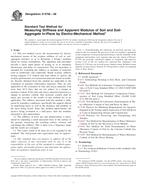
 ASTM D4647/D4647M-13..
ASTM D4647/D4647M-13..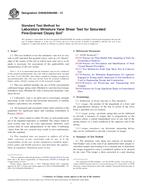 ASTM D4648/D4648M-13..
ASTM D4648/D4648M-13..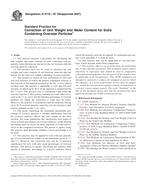 ASTM D4718-87(2007)..
ASTM D4718-87(2007)..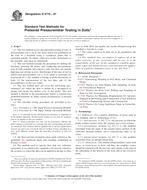 ASTM D4719-07
ASTM D4719-07 ASTM D4729-08
ASTM D4729-08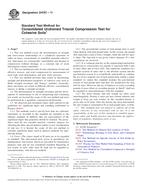 ASTM D4767-11
ASTM D4767-11
 Cookies
Cookies
